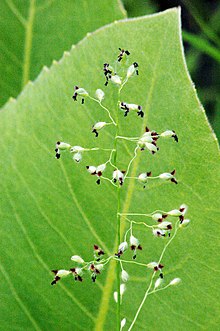| Dichanthelium leibergii | |
|---|---|

| |
| Conservation status | |
 Apparently Secure (NatureServe) | |
| Scientific classification | |
| Kingdom: | Plantae |
| Clade: | Tracheophytes |
| Clade: | Angiosperms |
| Clade: | Monocots |
| Clade: | Commelinids |
| Order: | Poales |
| Family: | Poaceae |
| Subfamily: | Panicoideae |
| Genus: | Dichanthelium |
| Species: | D. leibergii |
| Binomial name | |
| Dichanthelium leibergii (Vasey) Freckmann | |
Dichanthelium leibergii, known as variously as Leiberg's panicum, Leiberg's panicgrass, Leiberg's rosette grass, and prairie panic grass is a species of grass native to North America. It was named for its discoverer, John Bernhard Leiberg (1853-1913), a Swedish-born American botanist active in the western United States.
Description
Leiberg's panicgrass is a small perennial grass forming loose rosettes with culms between 30–60 centimeters (12–24 in) in height. It is distinguished from other similar species of Dichanthelium by a combination of the following characters:
- leave less than 15 millimeters (0.59 in) wide and less than 15-20 times as long as wide
- leaves hairy
- stem slender with narrowly ovoid panicle
- spikelets with long, soft hairs up to 1 millimeter (0.039 in) in length
- first glume narrowly ovate, reaching the middle of the spikelet
Distribution
Dichanthelium leibergii ranges north to Alberta, west to Kansas, and east to New York state. Although it is "fairly common" in Manitoba, it is a rare species across much of its range. It is state threatened in Indiana, Michigan, and Ohio and state endangered in New York. It is extirpated in Pennsylvania.
Ecology
In the Chicago region, it is a highly conservative species, with a coefficient of conservatism of 10. It occurs in high-quality prairie remnants, including wet prairie, mesic prairie, gravel hill prairie, as well as dry-mesic black oak savannas and oak openings. In a North Dakota study, its coverage increased significantly following the application of prescribed burning.
Conservation
Leiberg's panicgrass is threatened by habitat fragmentation, destruction, and invasive species. Appropriate management to maintain and increase populations of Leiberg's panicgrass includes removal of woody and invasive plant populations, prescribed burning, and prairie restoration.
References
- ^ "Dichanthelium leibergii". NatureServe Explorer. NatureServe. Retrieved 2018-09-29.
- "Dichanthelium leibergii". ipni.org. International Plant Names Index. Retrieved 2018-09-29.
- ^ NRCS. "Dichanthelium leibergii". PLANTS Database. United States Department of Agriculture (USDA). Retrieved 2018-09-29.
- ^ Penskar, M. R.; Crispin, S. R. (2009). "Special plant abstract for Dichanthelium leibergii (Leiberg's panicgrass)" (PDF). mnfi.anr.msu.edu. Michigan Natural Features Inventory. Retrieved 2018-09-29.
- Habitats and ecological communities of Indiana : presettlement to present. Indiana University Press. 11 July 2012. ISBN 9780253005205.
- ^ Wilhelm, Gerould; Rericha, Laura (2017). Flora of the Chicago Region: A Floristic and Ecological Synthesis. Indiana Academy of Sciences.
- Kirsch, Leo M.; Kruse, Arnold D. (1972), "Prairie Fires and Wildlife" (PDF), Bureau of Sport Fisheries and Wildlife, Northern Prairie Wildlife Research Center, retrieved 2018-09-29
| Taxon identifiers | |
|---|---|
| Dichanthelium leibergii |
|